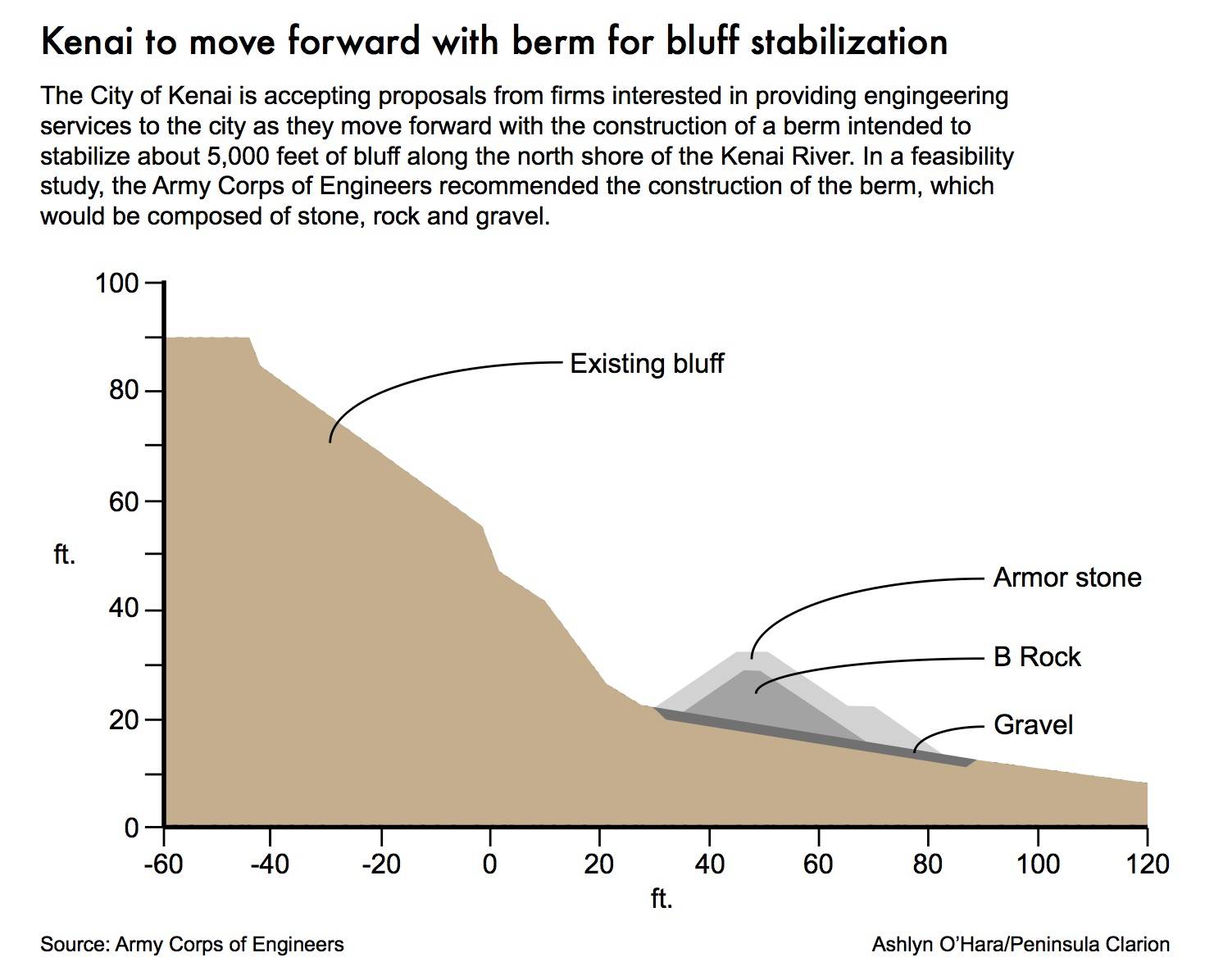The City of Kenai is soliciting requests for proposals for professional engineering services in coordination with the U.S. Army Corps of Engineers for their bluff stabilization project.
The Kenai Bluffs Stabilization Project, which has been in the works for decades, aims to stabilize roughly 5,000 feet of bluff on the north shore of the Kenai River, starting from the mouth of the river and ending near Pacific Star Seafoods.
In a Army Corps of Engineers feasibility study dated March 2019, the Corps recommended a protective berm at the toe of the bluff. According to the study, the Corps considered six different plans, including “no action,” that ranged from relocating the mouth of the Kenai River away from the bluff to relocating the threatened structures on top of the bluff before finally recommending the creation of a berm.
The city took the latest step forward with the project last month, when they opened a request for proposals for professional engineering services for the project. During a Tuesday pre-proposal meeting that was conducted remotely, Kenai Public Works Director Scott Curtin spoke to several potential bidders and extended the proposal submission deadline to March 4, or by one week.
Among other things, services requested by the city include site surveys, geotechnical work, engineering studies and draft plans. Curtin said that in consulting with the feasibility study conducted by the Corps, interested bidders should focus mainly on “Alternative 5,” which would see the construction of a berm at the base of the bluff. The berm is specifically intended to prevent water from flood tides from washing away material that collects at the bottom of the bluff between the bluff face and the berm and to protect the lower portion of the bluff from storm damage.
As the bluff continues to erode, soil that moves to the bottom of the bluff will accumulate between the bluff face and the berm, which will develop a more stable bluff slope. That stability will encourage vegetation growth, which will allow for further stabilization.
The berm, which would be roughly 5,000 feet long, would be composed of 42,400 cubic yards of armor rock, 33,200 cubic yards of B-rock and 13,100 cubic yards of gravel base.
Something else the berm is uniquely suited to address is bluff erosion that is not just caused by tides and Cook Inlet storms. According to the feasibility study, the bluff discharges groundwater year-round and can be seen about halfway up the bluff. The bluff also experiences wind erosion.
Curtin emphasized that throughout the process, the city would be heavily relying on the expertise of whatever company is chosen.
“You guys are the experts in this area, and we’re relying on you to come to us and kind of confirm your knowledge … and tell us, you know, what we need to do to get this project built,” Curtin said during the meeting.
In their study, the Corps reported that “Alternative 5” would provide average annual benefits of around $824,000 and average annual costs of $1,620,000, meaning the average net impact on the city would be a loss of around $796,000 annually.
The cost of inaction, however, could be much greater. The Corps estimates that, with no action, the city would incur $39,000 annually in land damages, $359,000 annually in structure and non-structural improvement damages and $66,000 annually in public infrastructure damages. That would be in addition to an average annual loss of $624,000 in recreation value calculated using a unit day value of $7.09 and an estimation of 88,000 annual visits.
Thirty one properties situated at the top of the bluff and containing 34 structures and 23 non-structural improvements would also eventually need to be condemned if no action is taken, the Corps said in the study.
Kenai City Manager Paul Ostrander said Tuesday that the city is expecting the final project cost to be lower than what the Corps estimated because they factor in potential costs that the city may not need to pay. Additionally, Ostrander pointed out that 65% of the project is being funded by a state grant that requires just a 35% match by the city.
Proposals will be evaluated on a point system, with a certain number of points awarded for things like project methodology and approach, qualifications of staff, the firm’s experience with Alaska or other remote and cole climates and cost. A maximum of 100 points is possible.
According to the study’s timeline, services would begin following contract execution in April of this year, with Ostrander estimating that the project would not take longer than five years.
More information on the Kenai Bluffs Bank Stabilization Project can be found on the city’s website at kenai.city.
Reach reporter Ashlyn O’Hara at ashlyn.ohara@peninsulaclarion.com.
CORRECTION: An earlier version of this story incorrectly reported the name of Pacific Star Seafoods as Pacific State Seafoods. The Clarion regrets the error.

